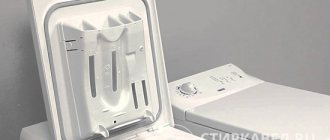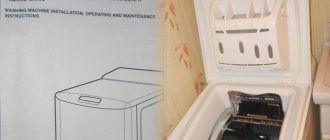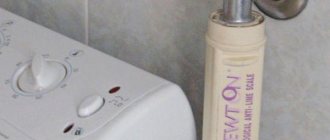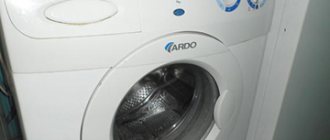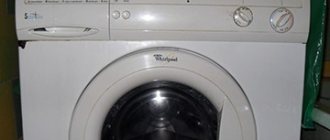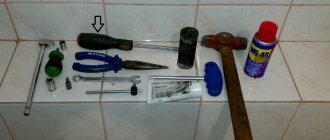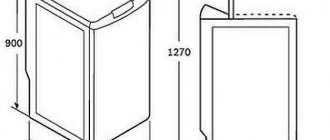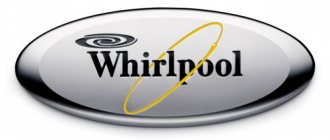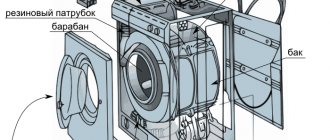The design of a washing machine, that is, the main parts and principles of operation, are the same for almost all front-loading models, regardless of the brand, be it Samsung, LG, Indesit, Bosch, Ariston or Candy. Vertical washing machines, equipment with additional functionality (for example, washing-drying units) or a new type of engine (direct drive) have some features.
A modern washing machine is a technique with a complex structure
Understanding how equipment works is necessary not only for those who are going to repair it. Knowledge of the processes taking place in the unit will help you treat particularly vulnerable elements more carefully and prevent some breakdowns.
In our article we will talk about the main components of an automatic washing machine and the principles of its operation.
What types of washing machines are there?
Washing equipment is usually divided into 2 large groups:
- Mechanical.
- Automatic.
Progress has long been made in improving the functionality of the washing machine, so it is not advisable to devote time to considering the mechanical family. Such models can only be found in technology museums.
The design of a washing machine is much simpler than it seems at first glance.
Much more urgent is the construction of an automatic washing machine. It includes a fairly large amount of precision electronics, knowing the operating principle of which, you can extend the uninterrupted operation of such equipment for a long time.
Engine
The main task of the electric drive is to make the drum rotate. The rotational motion from the motor to the drum is transmitted through a belt drive using pulleys. But in some models of washing machines, the motor is installed on the drum itself - this is called direct drive.
Engine failure can be determined by the following signs:
- the drum stopped rotating while the program was running;
- the engine does not rotate, the smell of burnt wiring is heard;
- the engine does not develop the required power (cannot turn the drum), and it gets very hot.
Important! It should be borne in mind that the latter problem can also occur when the electric brushes wear out.
If at least one of the above symptoms is noticed, then the electric drive should be repaired by a specialist who will determine where the device has a short circuit or where the windings have broken. But first, the technician will have to check the washing machine motor without removing it to make sure that the problem is located here.
Washing machine device - automatic
As mentioned earlier, the washing machine circuit includes many autonomous control elements, which are combined into a single system by an electronic unit.
general characteristics
In abstract form, a washing machine is:
- Frame.
- Water filling system.
- Washing system.
- Water drainage system.
A clear understanding of the technical device will extend the life of your favorite assistant and improve the quality of washing.
Currently, you can find front-loading or top-loading models on sale. According to the principle of operation, they are the same.
Internal organization
In the durable metal body of the machine, all electrical and mechanical systems are connected together, thanks to which the equipment receives its complete functional purpose.
The housing includes the following parts:
- Fill valve.
- Tank and drum.
- A heating element.
- Engine.
- Water drainage system.
- Control block.
The internal structure of an automatic washing machine consists of parts and assemblies that are responsible for a particular function.
All these systems will be discussed further, because the functioning of the washing machine largely depends on their correct use.
Where does the hot water come from?
As with front-mounted automatic machines, on vertical units a tubular electric heater – heating element – is responsible for heating. Once the user selects a mode and adjusts the temperature, the electronic board accepts the parameters and starts the heater. The part receives the signal, and upon completion of filling, its “spiral”, brought into the tank, begins to heat up.
To avoid overheating of the heating element, do not run three high-temperature cycles in a row!
The degree of heating is monitored by a thermistor - a temperature sensor. It looks like a metal tube and is located in the heating element itself. When the set degrees are reached, the device signals the module, which turns off the heater.
Technical device
Knowing and skillfully using each component of the washing machine, you can easily extend its service life for a very long time. Let's take a closer look at each technical block of this complex system.
Pressostat
The correct functioning of this sensor directly affects the quality of washing items. After all, the pressure switch is responsible for monitoring the level of incoming water. Accordingly, the more accurate its readings, the better the concentration of washing substances in the water is maintained.
A pressure switch or level sensor controls the amount of water in the tank.
Note! Incorrect functioning of the pressure switch can result in water overflowing outside the washing machine tank.
Symptoms of a faulty pressure switch are:
- Starting a wash without water.
- Incorrect level when washing - too much water or too little.
- Frequent repetition of cycles of pumping out dirty water and supplying clean water.
- Malfunctions of any of the washing programs used.
If any of the above problems occur, you must immediately call a technician to fix it, as well as prevent further failure of other systems.
Water intake valve
This unit is made in the form of an electromagnetic valve controlled by the main unit. This valve can have only 2 operating positions - open or closed. Its operation is possible only with a functioning pressure switch, otherwise the control unit will not be able to correctly monitor the level of water drawn into the machine.
Depending on the type, the valve can have from one to three coils.
Water is supplied through the valve, then the liquid is directed to the container for detergents, after which it enters the tank. Before intake, water is passed through a grid with small holes to mechanically clean the water from debris.
The main factor in valve malfunction is the inability to transition to the open state. Accordingly, washing becomes impossible. One of the signs of a faulty water supply system is the absence of characteristic clicks when starting a washing program.
Note! In the event of a malfunction, it is recommended to replace the entire supply valve; disassembling it yourself can result in a flood, since such devices are supplied in a solid plastic case, which is practically impossible to reassemble.
Tachogenerator
Tachogenerator is a device designed to control the number of engine revolutions. Not only the noise level of the wash, but also the stability of the washing machine during operation, as well as the durability of the belt that transmits the torque from the electric motor to the drum, depend on compliance with the established operating mode.
It is the tachometer that helps the electronic unit regulate engine speed.
The sensor is installed on the engine, and as its speed changes, the magnetic field of the device is adjusted. The control unit, receiving data about such a change, also adjusts the number of engine revolutions.
Symptoms indicating a malfunction of the tachogenerator include incorrect drum rotation speed in all washing modes. When soaking laundry, this can result in insufficient cleaning of contaminants from the surface of the fabric; during spinning, incorrect operation of the tachogenerator can result in poor quality of this operation, and in the most critical cases, destruction of the drum rotation mechanism.
temperature sensor
The temperature sensor is another important link that can ensure high quality washing. This element controls the level of water heating, and therefore is responsible for compliance with washing modes.
Having received readings from the temperature sensor, the control unit regulates the supply of electricity to the heating element, thereby achieving the best temperature match to the selected washing mode.
The thermistor determines the degree of water heating by sending a signal to the module.
A sensor malfunction is determined by a discrepancy between the water heating temperature and the selected program. As a rule, the degree of heating of glass in a front washing machine is measured. In top-loading models, the health of the sensor can sometimes be determined only by the presence or absence of control unit errors. Most often, problems in the operation of this sensor are determined precisely by the incorrect water temperature, and not by the lack of heating in principle.
Note! The lack of heating of water during washing may also indicate a problem with the heating element.
Other elements
Some modern models may contain elements such as an electronic clock that shows the time remaining until the end of the washing program. Many machines are equipped with an alarm system for the end of the program.
Remote control allows you to set modes and programs in the washing machine.
All these components are brought together by an electronic control unit.
Principle of operation
After starting the selected program, the hatch lock is activated. The inlet valve receives a signal from the electronic module and the water intake process begins. The pressure switch controls the filling of the container. The engine turns on, the rotation speed of which is controlled by a tachometer. A mixture of water and detergent is sucked out of the tray. At this stage, the laundry is soaked.
Then the heating element is turned on, while the water heating is controlled by a thermostat. The main wash process starts. At the end of this stage, the module sends a signal to the pump, the water is drained and the spin is performed. The pressure switch detects that there is no water in the tank, starts filling it, and then rinses the laundry. This process is repeated several times.
The final stage is the final spin (depending on the mode) and pumping out the water, after which the module signals the completion of the washing process and the hatch is unlocked.
Almost all washing machines work on a similar principle.
The design of washing machines may vary depending on the model, load type and the availability of additional functions. But having an understanding of the main components, you can troubleshoot simple problems without the help of a specialist. We hope that this information is useful to you.
Performing parts
As the name implies, this group of parts works by receiving signals from other sensors and does not generate any impulses on its own, and in some cases is a purely mechanical component.
The list of performing parts includes:
- Electrical engine.
- TEN-heater.
- Hatch locking device.
- Drain pump.
- Tank with drum.
- Shock absorption system (springs, counterweights).
- Drum pulley.
Let's look at each detail in more detail.
The electronic unit gives a command to the parts, after which they begin to work.
Electric motor
The washing machine engine generates revolutions at all stages of washing for the drum. The torque from it is transmitted to the drum through a drive belt or direct connection.
The engine speed is regulated with the participation of a tachogenerator; the control unit is responsible for supplying a particular voltage level to the motor. This ensures that the drum speed corresponds to the selected washing mode.
Their design is reliable, so such motors rarely break down.
As a rule, the electric motor is a fairly reliable component of the washing machine; it rarely fails. The most common causes of failure are water, insects, and foreign objects getting inside electrical components. This leads to a short circuit in the winding; in the event of such a breakdown, the engine must be repaired, and if such work is impossible, it must be replaced.
The engine is located under the drum; the most common method is a belt connection to the drum.
Electric heater (TEH)
The heating element in modern washing machines is often a consumable part. All due to the low quality and high aggressiveness of water in modern pipelines. Scale is the main reason for heater failure. Therefore, many manufacturers recommend periodic maintenance of their machines with special cleaning agents.
The electronic unit sends a specified signal to the heating element, after which heating is performed.
A heating element is a tubular device, the metal cavities of which are filled with a special composition to improve heat transfer.
It is located at the bottom of the drum, access to it is quite easy and, if necessary, anyone can replace the heating element.
Note! When carrying out such work, it is necessary to disconnect the washing machine from the power supply and drain the water from the tank.
Hatch locking device
In essence, this system is a simple solenoid lock, which is in the “open” mode when not working.
When you turn on any washing program, the hatch for loading things is blocked to prevent it from opening while the machine is operating.
This is an electronic door lock. You manually close only the mechanical door lock. When the program starts, a click is heard, which indicates that the hatch is locked.
After completing the selected program, the lock returns to its non-working mode, allowing access to things.
Drain pump
This mechanism is in second place after the heating element in terms of failure rate. Especially if before washing it is not practiced to check the pockets of things and remove excess change from them. Once in the drain system, such unwanted parts block the unhindered drainage of water, which can lead to pump failure.
Almost every machine has a system for cleaning drain pipes, which allows, first of all, to remove unwanted elements from them. After the drum with dirty clothes has gone through several cycles, the water is usually replaced. This is what the drain pump is used for.
The pump allows you to pump water out of the tank after washing and rinsing. There are synchronous and asynchronous pumps.
Tank design
The tank is the most bulky element of the washing machine. It is a plastic case containing a metal drum, a heating element and a thermostat.
The tank must have pipes for connecting the water supply system and draining it.
Recently, many manufacturers have been using non-separable type tanks, in which, if the rotation bearing fails, it is necessary to completely replace this element, or to purchase new equipment.
The tank can be made of steel or plastic. The latest development is a polyplex tank.
Shock absorbers
When operating at high speeds, the washing machine tank is inevitably exposed to large forces that rock it. Shock absorbers are designed to smooth out such vibrations.
During the operation of the washing machine, they take on all the loads, so they also break down with frequent overloads. The main signs of faulty shock absorbers include excessive vibrations of the washing machine body. This may eventually cause the main drum bearing to break.
Dampers or shock absorbers are parts that dampen vibrations during the operation of the SMA.
One of the symptoms of faulty dampers is that the electric motor drive belt periodically falls off.
Note! Replacing faulty shock absorbers yourself is not recommended, since it requires dismantling the drum mechanism.
Springs
Springs provide an additional damping effect when the washing machine operates at high speeds. Unlike shock absorbers, which dampen longitudinal vibrations, springs are responsible for the absence of horizontal vibrations.
It is thanks to them that the tank remains in a relatively motionless state on its axis, as far as possible. Being a simple mechanical element, springs can stretch due to frequent overloads, in which case they should be replaced. This can be done without removing the drum. It is enough to open the top cover of the case and carry out the necessary work.
Springs hold the tank on top and perform the same function as shock absorbers.
Pulley
The drum pulley is involved in the process of transmitting torque from the electric motor. Most often, such work is performed by a drive belt; in some cases, you can find models with a direct connection between the pulley and the drum.
This part is quite reliable and can only fail if the belt is skewed, but under normal operating conditions of the washing machine this practically never happens.
If the washing machine has a belt-driven motor, then a pulley is attached to the tub.
Counterweights
The heaviest and most monumental part of the entire “washing machine”. It can be produced in two types - top plate and side panels. In both cases, it is a dense and heavy element that provides additional vibration damping and prevents the drum from transmitting strong vibration to the body.
To ensure the best stability, when installing the machine in a permanent place, you need to ensure that it is level.
Heavy blocks are made of concrete or plastic. They are bolted to the outside of the tank to restore balance.
Drum
The drum structure of an Indesit washing machine is a metal cylinder with a large number of holes through which water flows and drains to the clothes. The tank and drum are fastened together with a rubber cuff. This design allows you to dampen vibrations that occur when the drum rotates, and also ensures the tightness of the tank.
A shaft is attached to the back of the drum, through which it rotates via a belt drive. A bearing is installed between the shaft and the tank body, which performs 2 functions at once:
- Ensuring drum rotation.
- Additional sealing of the tank.
Located inside the tank, made of stainless steel.
If this bearing fails, a complete replacement of the tank may be required. This happens in cases where the system is not dismountable.
Important! The main reason for drum bearing failure is periodic excessive overload during washing. Therefore, you must always adhere to the requirements of each model for the maximum weight of laundry available for loading.
"Heart" of the machine
The “heart” of a washing machine is its engine. It is the electric motor that accelerates the drum shaft, ensuring rotation of the cylinder at the desired speed. The number of revolutions is controlled by a tachogenerator, which clings to the engine and constantly monitors the pace, eliminating chaotic rotation and sudden changes in direction.
The driving force is an electric motor. Modern vertical machines are equipped with inverter motors, which are connected directly to the drum shaft, without the use of a drive belt. This system eliminates “middlemen”, which makes unwinding the cylinder more efficient, reliable and safe.
Some top-loading washing machines have commutator motors. Here the impulse from the motor is transmitted to the drum through a drive belt wrapped around the pulleys. This option is cheaper, but more unreliable: the elastic often falls off, breaking or stretching. The second disadvantage is the electric brushes, which during operation of the machine wear off on the engine body and periodically need to be replaced.
Other details
The most important components of a washing machine were discussed above, but it also contains other equally necessary elements. More about them later.
Dispenser tray
This tray ensures that cleaning agent and freshener are dispensed when necessary. Depending on the means used, 1, 2 or all 3 sections of the tray may be used. It is located on the front panel in the upper tier near the control buttons and information panel.
The tray is placed in a hopper to which hoses from the inlet valve are connected. Through them, water flows into the compartments to collect the powder.
Rubber cuff
Responsible for the tightness of the connection between the drum and the tank. It can be damaged by sharp objects, so it requires careful handling. For example, using bags for washing things.
The rubber seal is located on the hatch and serves to seal the door.
Hoses and pipes
Integral components of the washing machine are also a number of pipes and hoses. These include:
- Hose for supplying clean water from the water supply.
- Hose for discharging dirty water into the sewer.
- Connection pipe between drum and pump for dirty water.
All these elements are also involved in the washing process. The only problem with using them is the blockage, which can be easily removed by simple cleaning.
The hose is installed at the water inlet. Its other part is attached to the body.
Weights and shock-absorbing system
When the drum unwinds, centrifugal force inevitably appears, which is absorbed by shock absorbers. They compensate for outgoing vibration, preventing the equipment from “jumping” around the room and hitting the wall. The stability of the washing machine is ensured by the following details:
- dampers - vibration dampers with a built-in spring, connecting the washing tank to the machine body;
- springs - the tank is suspended from the top and sides;
- counterweights are concrete blocks that are attached to the bottom or sides of the vertical, weighing down the entire structure.
The shock absorption system takes on the entire “shock”. Due to constant vibration, dampers wear out, springs stretch, and counterweights become loose. Especially if the washing machine is not installed correctly or has been used for too long. In this case, it is necessary to tighten the fixing bolts and replace worn components.
Washing process
Having learned from all the previous material how the washing machine works, you can easily begin the process itself. The algorithm consists of the following stages:
- Preliminary sorting of things. In order not to spoil the appearance of your clothes, things are divided into black, white and colored. All three groups are washed separately from each other.
- Checking pockets for foreign objects, packing clothes with large zippers into laundry bags.
- Loading the washing machine drum in accordance with the maximum weight of dry laundry recommended for each specific model.
- Closing the tank of the machine with the front door. You must make sure that the lock is securely closed, otherwise the locking electromagnet will not work and the washing will not start.
- Loading detergent into the tray.
- Selecting the required washing program. Depending on the type of control, manual or automatic, this selection occurs either using a rotary mechanism or by pressing the button for the corresponding washing mode.
- Controlling the start of water flow into the drum and the start of its rotation.
- Control over the activation of the heating element during the washing process by simply touching the glass part of the door.
- After the end of the washing cycle, open the ram and remove the washed items. Removing debris, hair and other particles from the rubber cuff that did not escape through the drain channels.
In modern machines, all actions are performed automatically; you just need to select the washing mode.
It is also recommended to leave the drum ajar for a few minutes after finishing washing to allow it to dry.
Main tanks
The key element of the washing machine is the tank - a sealed plastic reservoir. It is tap water that is mixed with the powder. On vertical machines, the tank is positioned with the hole facing up, and on front ones – forward.
The drum is made of stainless steel. Clothes are placed in the cylinder, then the motor spins it to a predetermined speed. It is smaller, has perforated walls and rib punches - plastic blades that “mix” things and foam the powder.
The drum volume varies from 3.5 to 15 kg and depends on the capacity of the machine.
How to care for your washing machine
The main methods of care include periodic cleaning of the insides with a special solution that prevents the formation of scale. It is possible to add such products with each wash, which will ensure a long service life for the machine.
When purchasing household appliances, the user is obliged to take care of their proper use.
It is recommended to periodically check the debris collection compartment at the bottom of the machine to prevent the accumulation of particles remaining inside.
By understanding the operating principle of an automatic washing machine, you can provide yourself with reliable equipment for a long time to return your things to their former shine.
Motor brushes
To transfer electricity from the power source to the motor commutator, special electrodes called brushes are used.
Electric brushes are an integral part of all commutator motors. Washing machines of such brands as Indesit, Samsung, Veko and others are equipped with these drives.
Over time, as the electrodes wear out, contact with the collector is lost, and the engine stops working normally or stops completely. The main signs of brush wear are strong sparking in the area of the engine commutator and a drop in electric drive power. Replacing brushes is a fairly simple process and does not require the participation of a specialist.
Hoses
There are 2 hoses connected to the washing machine: inlet and drain. Hoses differ in type and design:
- the inlet hose is more designed for the high water pressure present in the water supply and is used to supply liquid to the tank;
- The drain hose has a larger diameter than the drain hose and is used to drain water from the unit’s tank.
Basically, hoses fail due to damage to their casing or due to a breakage of the fastening nut, which is made of plastic. If the hose is faulty, there will be a flood in the house.
To prevent these problems from occurring, it is necessary, first of all, to use the water supply hose correctly. But if malfunctions nevertheless arise in any of the hoses, then the part with the defect must be replaced. It is very important to correctly connect the hoses to the washing machine.
Of course, in case of serious damage to the washing machine, it is better to invite a specialist. But not everyone realizes that most faults in household appliances can be fixed on their own and at the same time saving a significant amount that would have to be paid after the repair. After all, it includes the cost of calling a technician, the cost of the work performed, and the inflated price of the part being replaced. If you decide to repair your washing machine yourself, then all the parts for this purpose can be purchased by visiting the spare parts store https://easyfix.com.ua/.
Filters
Typically, modern washing machines have 2 filters installed: one at the inlet, in front of the inlet hose, and the other at the outlet, in front of the drain pump. Each filter will perform its functions as follows:
- the inlet filter ensures that the water entering the machine is cleaned from mechanical impurities (rust, sand, scale, etc.);
- The outlet filter protects the pump from small objects from the tank (hairpins, pins, buttons, threads, slagged powder residues, etc.) getting into it.
If the filter installed at the entrance to the device is clogged, water will be drawn in very slowly, and sometimes, if the mesh is severely clogged, it will stop flowing into the tank altogether. If the exhaust filter is clogged, there may be more symptoms:
- the machine stops draining water, and you can hear the pump running;
- in the drain and spin mode, the water drains very slowly;
- an error code corresponding to this malfunction appears on the display;
- The machine does not switch to rinse mode.
To get rid of the above problems, you will need to clean the washing machine filters.
Stuffing box
To connect the drum to the tank, which is a stationary part of the washing machine, without causing water leaks, a special rubber ring called an oil seal is used.
The seal also prevents moisture from entering the shaft and bearings mounted on it. As you might guess, if the oil seal is damaged, then the surest sign of this breakdown is the appearance of a puddle under the washing machine. To replace the oil seal, you will need to remove the belt, pulley and disconnect the drum.
Bearing
This part is installed in the tank oil seal and ensures rotation of the drum with minimal resistance.
The bearing may become unusable due to natural wear or, what happens more often, due to a faulty seal that begins to leak water. When moisture gets on the bearing parts, they begin to rust and are destroyed very quickly.
If a bearing breaks, you can hear grinding, crackling and other noises in the drum area when the unit is operating. Also, the noise does not stop if you rotate the drum manually. Replacing a bearing is a little more difficult than, for example, changing a heating element or pump. But still, any home craftsman can complete this task.
heating element
The main function of the heating element is to heat water in the tank in which it is installed.
Important! The heater often fails due to “fouling” of scale if the user of the washing machine has not taken measures to remove it.
Burnout of the heating element is sometimes accompanied by a loud bang and sparking in the rear of the unit. This means that a short circuit has occurred (the heater has penetrated the housing). To replace the heating element, no special knowledge is required. It is enough to remove it, read the markings and purchase a heater with the same parameters.

